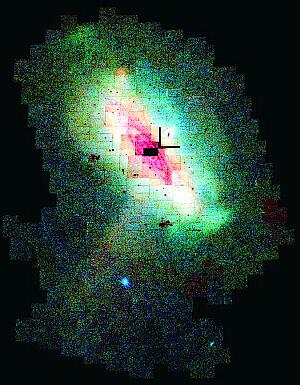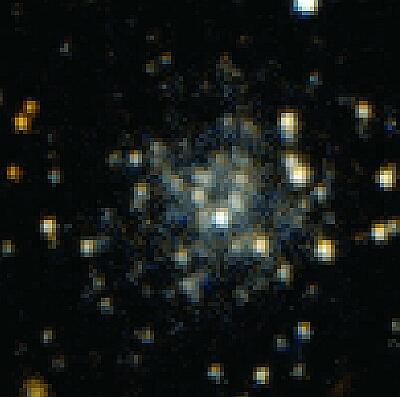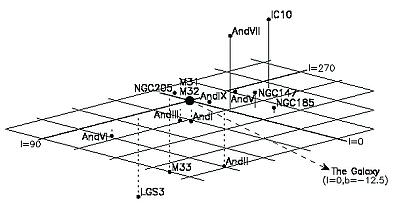A PANORAMIC
DEEP VIEW OF THE STELLAR HALO OF ANDROMEDA GALAXY
INT+WFC
The structure of the outer regions of galaxies is a key area in which to
look for fossil remnants of the accreted masses from which the galaxies that
we see today are thought to be built. The importance of these regions has
increased in recent years as cosmological theories of structure formation
become more exact in their predictions, and the observational instrumentation
required to conduct these detailed analyses becomes more sophisticated.
Currently composed of 165 individual pointings of the Isaac Newton Telescope
Wide Field Camera (INT WFC), the M31 halo survey consists of photometry for
over 7 million sources, on a photometric system accurate to 2% over ~40 square
degrees on the sky, in some places probing the halo of Andromeda out to 6°
(~80 kpc). Observations of 800–1000 seconds in the Johnson V (V') and Gunn
i (i') passbands are deep enough to detect individual RGB stars down to V'=
0 and Main Sequence stars down to V'=–1. This unique dataset has provided,
for the first time, a panoramic deep view of the stellar halo of a giant
galaxy thought to be similar to our own Milky Way.

|
A multi-colour mosaic of the INT
WFC survey of M31, involving 165 individual pointings over 40 square degrees
of the sky, which shows the inhomogeneity of this system. Metal-poor/young
stars are coded blue whilst metal rich/older stars are coded red. The (colour-dependant)
substructure is obvious, and surprising given the pristene nature of the
Galactic disk. The dwarf galaxies Andromeda I & III are visible at the
bottom left of this figure; the newly discovered dwarf spheroidal, Andromeda
IX, is just visible at the top left as a small blue dot. NGC 205 is also
visible in this figure, at the right-hand side of the disk This spectacular
image shows in amazing detail the wealth of information that the INT is helping
to reveal about the structure of this previously invisible region of galaxies.
[ JPEG | TIFF
]
|
Despite exhibiting a near pristene disk, M31’s halo is full of substructure
and points to a history of accretion and disruption. The most obvious piece
of substructure is the giant stellar stream (visible in the south-east). This
extends to near the edge of the survey —a projected distance of some 60 kpc.
In fact, by examining the systematic shift in the luminosity function of
the stream as a function of galactocentric radius, a length much greater than
100 kpc is found. The similarity of the colour of this feature with the loop
of material at the north of the survey suggests it seems likely that the
northern feature is an extension of the stream, after it has passed very
close to the centre of the potential of M31.
A second large stellar stream candidate has also been identified with the
INT WFC photometry. The visible part of this feature is some 15 kpc long.
The progenitor of this feature appears to be the satellite galaxy NGC 205.
This object has long been known to be tidally perturbed but it is only now
that the full extent of its disruption is becoming clear. Considerable amounts
of other substructure exists in addition to these streams.
As well as these and many other obvious substructures, the INT WFC is allowing
the identification of previously unknown globular clusters in the halo of
M31. These include some of the most distant so far discovered, at projected
radii of ~80 kpc. So far 14 have been found, including a whole new class
of cluster, much sparser than typical globulars. These objects, of which
three candidates have currently been identified, are far less concentrated
and have larger half-light radii than normal, making their appearance fuzzy
and diffuse. The identification and quantification of the globular cluster
system provides yet another valuable handle on the accretion history of this
giant galaxy.

|
An example of a new class of globular cluster
around M31, much sparser than typical globular clusters, being discovered
by the INT WFC survey. Fourteen new globular clusters have so far been discovered,
many at large projected radii.Three of these objects have morphologies similar
to the above.The half- light radii of these clusters are significantly larger
than normal. [ JPEG | TIFF ]
|
The other spiral in the Local Group, the Triangulum Galaxy (M33), has also
been surveyed with the INT WFC. The structure of this galaxy is striking
in comparison to M31: the lack of substructure is immediately obvious. It
appears that not all spiral galaxy haloes need look like M31. There is then
the question of the M31 dwarf satellite galaxies. The homogeneous nature
of the data has allowed accurate and internally self-consistent distances
and metallicities to be measured for each of these galaxies. For the first
time, the three dimensional spatial distribution of these objects, has reliably
probed and revealing that far from being isotropically distributed and unbiased
indicators of the potential of Andromeda, there are strong indications that
these objects are preferentially located on the near side of Andromeda, towards
the Galaxy.

|
The distribution of the satellite galaxies of M31,
as derived from the INT WFC photometry of these objects. The coordinate system
is an M31–centric system. The plane is the plane of the disk of M31, and
each cell corresponds to 100 kpc×100 kpc. l is a longitude measured
around the disk of M31, such that l=0 is the longitude of the Galaxy. b is
a latitude, measured from the disk of M31. Solid lines indicate objects located
above the plane of the disk, while dashed lines indicate objects below the
plane of the disk. A clear tendency for the satellites to lie on the near
side of M31 can be observed, and suggests an intriguing correlation between
the M31 satellites and our own Galaxy. [ JPEG |
TIFF ]
|
Some
references:
- A. McConnachie,
A. Ferguson, A. Huxor, R. Ibata, M. Irwin, G. Lewis, N. Tanvir
ING Newsl., 8, 8.
- "Andromeda
Galaxy - Cannibal on our doorstep?", RAS Press Release, 25 March 2004.
|





